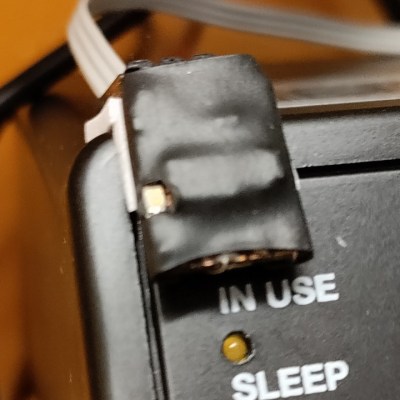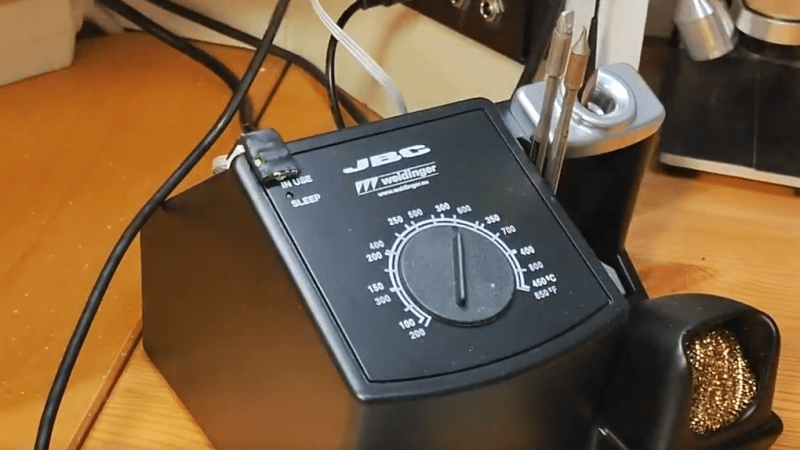A fan to remove fumes is a handy thing to have when soldering, even better is a fan furnished with a filter. Better still is a fan that activates only when the iron is in use, turning off when the iron is in its stand. Now that’s handy!
 [Petteri Aimonen] made exactly such a device when he noticed his JBC BT-2BWA soldering station could detect when the iron is removed from its stand, and indicate its operating mode via status LEDs. Broadly speaking, when the iron is removed from its cradle the green “in use” LED is on. By turning the fan on whenever that LED is lit (and turning it off when it becomes unlit), fume extraction gets a little more elegant and efficient.
[Petteri Aimonen] made exactly such a device when he noticed his JBC BT-2BWA soldering station could detect when the iron is removed from its stand, and indicate its operating mode via status LEDs. Broadly speaking, when the iron is removed from its cradle the green “in use” LED is on. By turning the fan on whenever that LED is lit (and turning it off when it becomes unlit), fume extraction gets a little more elegant and efficient.
Instead of tapping directly into the soldering station’s hardware to detect the LED’s state, [Petteri] went for a completely noninvasive solution that made good use of a few spare parts and a small bit of copper-clad board. The PCB is nothing more than piece of copper-clad board with lands scratched out with a hobby knife.
This tiny board sits atop the soldering station, parking a photodiode directly above the “in use” LED. The circuit is a simple comparator whose output controls fan power via a MOSFET, and a top-facing LED provides as a duplicate “in use” indicator, since the original is hidden under the tiny board.
Even for one-off designs like this, creating a PCB layout in an EDA program like KiCad is still worth doing because one can use it to scratch out lands on a copper-clad board, a technique with similarities to Manhattan-style circuit construction.
















Does what it needs. Good hack.
I thought a “hack” was turning something into something else. Adding a feature to me does not “hack” it, or building a new device, this is why for a long time I never posted on here.
It’s a shame that you’ve never posted because of that. Hacking is changing something beyond it’s original design or intent, be it adding, removing or modifying
Say you lost the battery cover for a portable device and then use duct tape to hold the batteries in. What would you call that?
Not a hack, cheap and ugly fix, and a sticky mess down the road, a hack, no.
Hack is modifying something to do a new function. Tape is a bandaid to a lost cover.
Is turning a fan on and off not a new function then?
That is just proper use of duct tape.
So your first post in a long time is to argue that adding a feature without modifiying the device is not a “hack”. Well what is a “mod” then? Are they the same, “hack” and “mod”? What if you just make a new firmware, you aren’t modifying the old firmware, is that a “hack”, a “mod” or something else? What is it when you add a chip to a gaming device, which doesn’t actually modify the device itself or the firmware? What is this then, an addon?
I’d still say a hack, even though the device itself was not changed, but fine, good addon. Don’t get your panties in a bunch.
If you replaced the fw I would call that a hack, you changed something in the unit changing it’s function. Not simply add something that did not change anything to the irons function. No need for insults.
you are right.
It is a trick based on hack, trick, magic rating system.
hack works once; trick works more than once; and magic works all the time.
This website is just being humble by calling it ‘Hackaday.’
BTW have you heard of scale nanodijkstra?
In 1983 working for Mitsubishi at the age of 17 I used the KISS design, a micro switch with the metal lever arm installed in the Hakko 926 (the best) iron holder, super simple.
🤦♂️
Oz, true technically a ‘mod’ in the hardware sense, yet also a hack in terms of functional improvement of overall process…
The Hack would be to modify the “current system” to provide another function (in whole or in part). This is just adding hardware to provide the fume blowing function.
I designed a clean power supply output on/off switch for supplies that don’t have that function and IMO not a hack, just added a function. If I modified the circuit to do this function I would call it a hack (or since I am old, it’s a modification).
https://hackaday.io/projects/hacker/1196929
Nice idea, and well done! Not that my setup is noisy, as it’s using a big Noctua fan hooked up to a variable DC supply, but I think I’ll try something similar with either my Hakko or AOYUE soldering stations.
Although the hack in question uses a photodiode (and is arguably the simplest method), perhaps triggering can be done with a hall-effect sensor…? Or would the steel of the iron holder interfere with its operation? Just throwing ideas into the void. :)
“Even for one-off designs like this, creating a PCB layout in an EDA program like KiCad is still worth doing because one can use it to scratch out lands on a copper-clad board, a technique with similarities to Manhattan-style circuit construction.”
you’ve entirely lost me.
so because the design is a one-off, there’s significant benefit somewhere to spending hours designing it in a program, scaling it, printing it, re-verifying the scale to re-print, only to hand-cut the traces anyways?
i know, i know, someone somewhere could design this in negative 12 seconds. but i’m not one of those people. it takes me hours to design a pcb in a program, but minutes to do it by hand. but it’s also why i don’t submit most of my projects here, the audience wouldn’t approve.
not every project needs to require a computer program for completion of mechanical tasks. this walled garden thinking really hurts the progression of problem solving for others approach to any project they encounter.
Keep It Smart and Simple.
I hope Donald sees this, too: I was about to celebrate the EDA message, on several fronts.
Posterity. I even like hard copies of the capture to go between pages on that date in my lab notebook. I know it’s old-school, substitute with equivalent, if needed.
EDAs are *so good* right now! Ofc I’m gonna say libre ones are the top of the list (KiCad!)
Then, _why not_? It’s fun, copper clad and Manhattan style is good, and you don’t have to go to RF simulation or something right off the bat. Or maybe you will later, and have only a little extra work to send to a fab.
Why not.
No. Control the fan separately and leave the fan running while you’re working. The iron gives off fumes while the tip is hot, and putting it on a stand is not going to instantly cool it. Turning off the ventilation while the tip is still hot is not safe; you need to keep it running until the tip is fully cooled.
Im soldering for more than 30 years with lead poisoned solder. Have no fume exreactor an im still alive…
The fumes aren’t the lead geting in th air but the flux.
And death is not the only thing that exposure to chemicals/compounds can do to you. In fact I think skin and lung conditions that are just constantly annoying are more often the result of extended exposure I bet. Although – I have no idea what, if anything, the fumes of soldering is suppose to do to people.
Oh and incidentally, I think the amateur is likely more exposed to the classic fumes from the core of the solder, whereas the people doing thing as a job would face the seperate flux compounds, which are more chemically created I think, not based on resin from trees, and as such might be less healthy?
Lots of questions on this one.
Solder can have any kind of flux core, and you can get natural flux seperately. And natural flux doesn’t mean safer, cyanide and arsenic are also natural, as is the lead in solder. The only real difference with having seperate flux is you can mix and match different solders with different fluxes, and don’t have to worry about flux running dry.
It’s not just about the personal exposure to lead but when your project inevitably ends up in landfill, the amount of lead your reintroducing back in to the environment.
soldering fumes are a way of life, and a way out of same. i think il keep mine thank you.
My system is manual, and a bit more extensive.
https://www.thingiverse.com/thing:1589533
I’m surprised extractors are not alexa/google/siri controlled these days.
Makes you think huh, how people in tech avoid the damn things it seems.
I made something like this (black tape, LDR, comparator) to turn on the sound system when we turned our TV on. So I’m kinda with Donald about the “design it in CAD” line — I mean, if I had, then Petteri could have just copied my PCB design…
But I _enjoy_ scratching out circuits on copper scraps as a nice break from the computer.